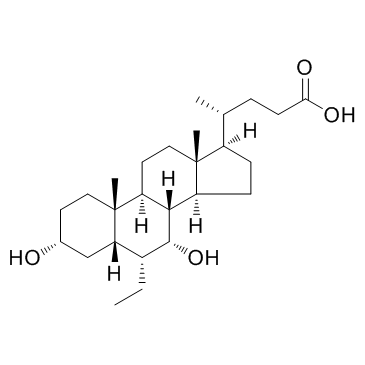Obeticholic acid
Modify Date: 2025-08-22 17:52:56

Obeticholic acid structure
|
Common Name | Obeticholic acid | ||
|---|---|---|---|---|
| CAS Number | 459789-99-2 | Molecular Weight | 420.625 | |
| Density | 1.1±0.1 g/cm3 | Boiling Point | 562.9±25.0 °C at 760 mmHg | |
| Molecular Formula | C26H44O4 | Melting Point | N/A | |
| MSDS | N/A | Flash Point | 308.3±19.7 °C | |
Use of Obeticholic acidINT-747 is a potent and selective farnesoid X receptor (FXR) agonist with an EC50 of 99 nM. |
| Name | (4R)-4-[(3R,5S,6R,7R,8S,9S,10S,13R,14S,17R)-6-ethyl-3,7-dihydroxy-10,13-dimethyl-2,3,4,5,6,7,8,9,11,12,14,15,16,17-tetradecahydro-1H-cyclopenta[a]phenanthren-17-yl]pentanoic acid |
|---|---|
| Synonym | More Synonyms |
| Description | INT-747 is a potent and selective farnesoid X receptor (FXR) agonist with an EC50 of 99 nM. |
|---|---|
| Related Catalog | |
| Target |
EC50: 99 nM (FXR) |
| In Vitro | 6-ECDCA increases the expression of FXR-regulated genes in rat hepatocytes[1]. INT-747 reduces expression of liver JNK-1 and JNK-2[2]. INT-747 (256 μg/mL) shows complete inhibition of bacterial growth in all strains tested. Intestinal permeability remains unaffected after INT-747-addition to an IFN-γ-exposed intestinal epithelium of Caco-2 cells[3]. |
| In Vivo | 6-ECDCA (10 mg/kg/day) completely reverted cholestasis induced by E217α. Administration of 6-ECDCA partially prevents the impairment in total bile acid output caused by E217α by increasing the relative abundance of β-MCA and TCDCA and TDCA[1]. INT-747 (10 mg/kg) and HS increases the pulmonary congestion in the animals.INT-747 does not improve renal pathology in the HS-fed animals[2]. INT-747 (5 mg/kg) significantly increases survival in BDL rats. INT-747-treated BDL rats exhibits a significant selective ileal increase in expression of pore-closing claudin-1. Ileal expression of ZO-1 is significantly up-regulated in INT-747-treated BDL rats[3]. |
| Animal Admin | Initially, all animals (at 6-weeks age) are placed on a standard rodent diet for a week. Baseline blood and urine samples are collected and basal blood pressure (BP) is measured prior to grouping the animals. Subsequently, the animals are randomized into low (LS; n=9) or high salt (HS) diet groups. Hypertension is induced in the HS group by daily high-salt diet feeding and the group is subdivided to receive one of two doses of INT-747: low dose (10 mg/kg/day; n=15) or high dose (30 mg/kg/day; n=15) in 1% methylcellulose; or vehicle (1% methylcellulose in distilled water; n=15) orally everyday for 6 weeks. In parallel, the LS group also receive 1% methylcellulose. BP is measured weekly for the duration of the study as described below. |
| References |
| Density | 1.1±0.1 g/cm3 |
|---|---|
| Boiling Point | 562.9±25.0 °C at 760 mmHg |
| Molecular Formula | C26H44O4 |
| Molecular Weight | 420.625 |
| Flash Point | 308.3±19.7 °C |
| Exact Mass | 420.323975 |
| PSA | 77.76000 |
| LogP | 5.68 |
| Vapour Pressure | 0.0±3.5 mmHg at 25°C |
| Index of Refraction | 1.530 |
| Hazard Codes | Xi |
|---|
| 6α-ethyl-chenodeoxycholic acid |
| Cholan-24-oic acid, 6-ethyl-3,7-dihydroxy-, (3α,5β,6α,7α,8ξ)- |
| 6alpha-Ethyl-chenodeoxycholic acid |
| Obeticholic acid |
| 1osv |
| 6-Ethylchenodeoxycholic acid |
| INT-747 |
| (3α,5β,6α,7α,8ξ)-6-Ethyl-3,7-dihydroxycholan-24-oic acid |
| UNII-0462Z4S4OZ |
| 6-ECDCA |
| OCA |
| CHC |

